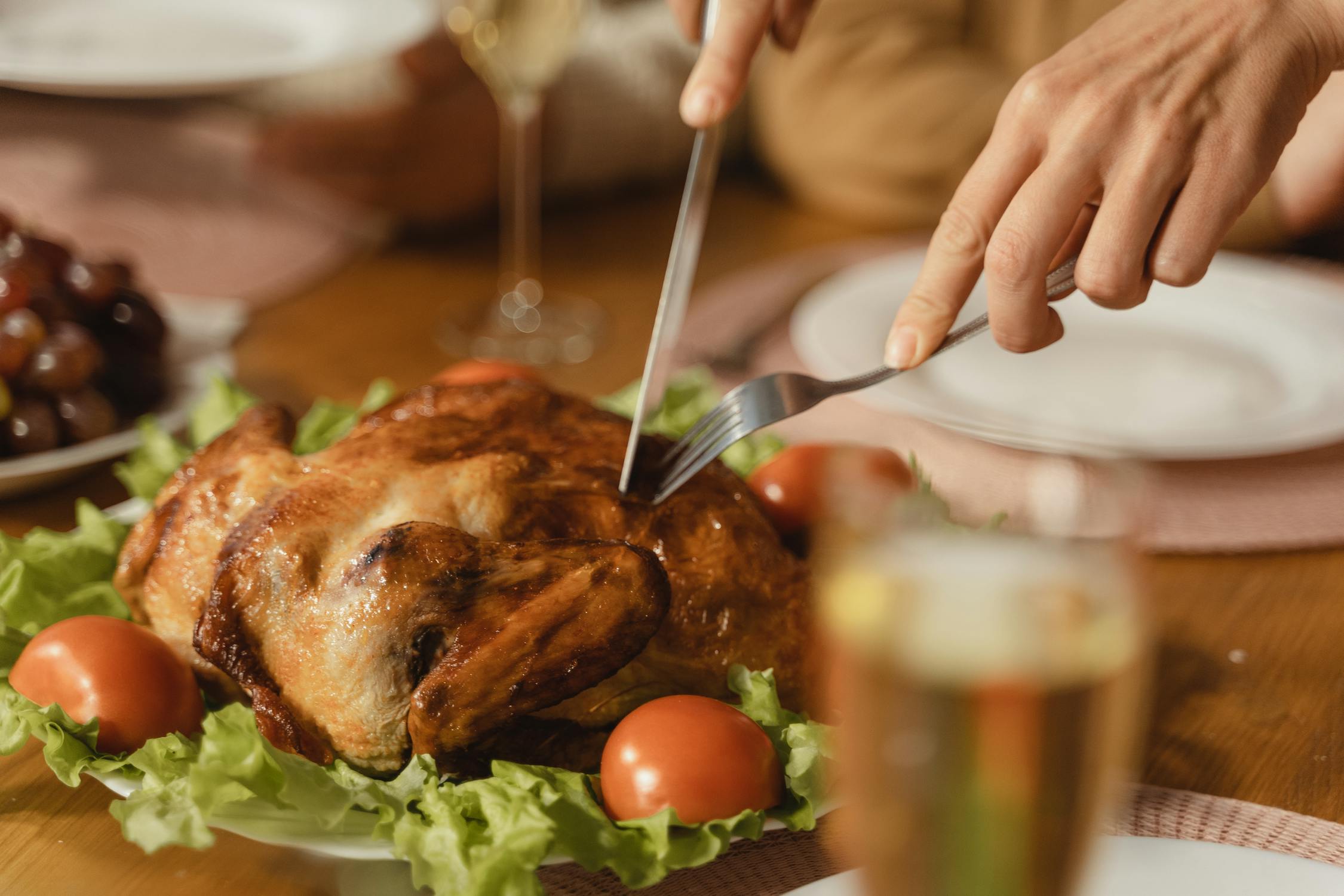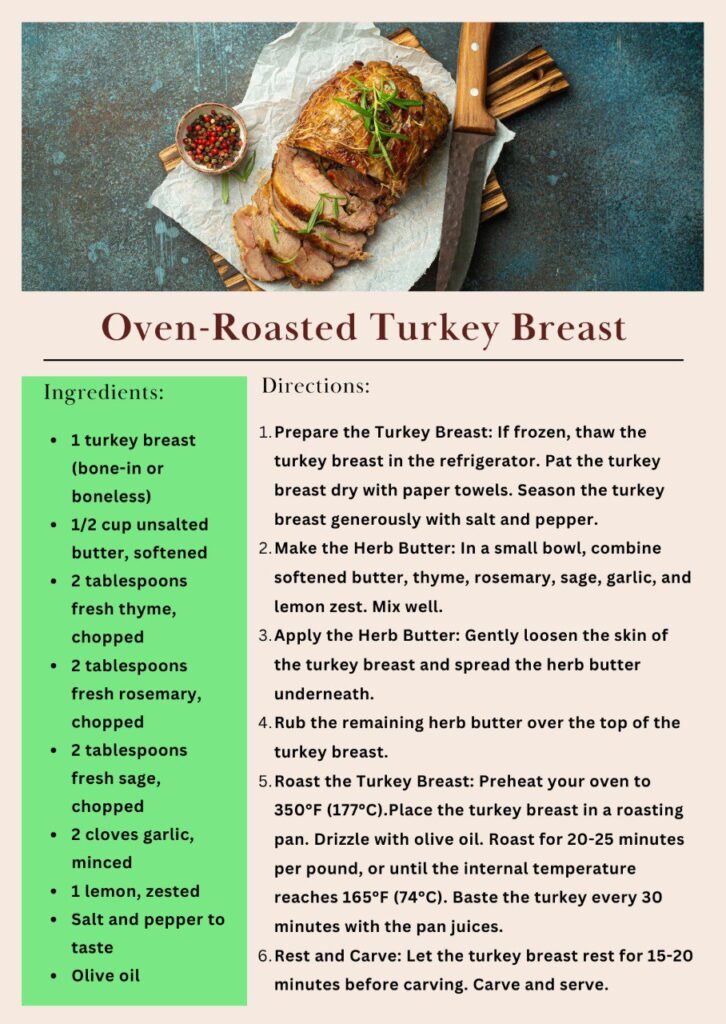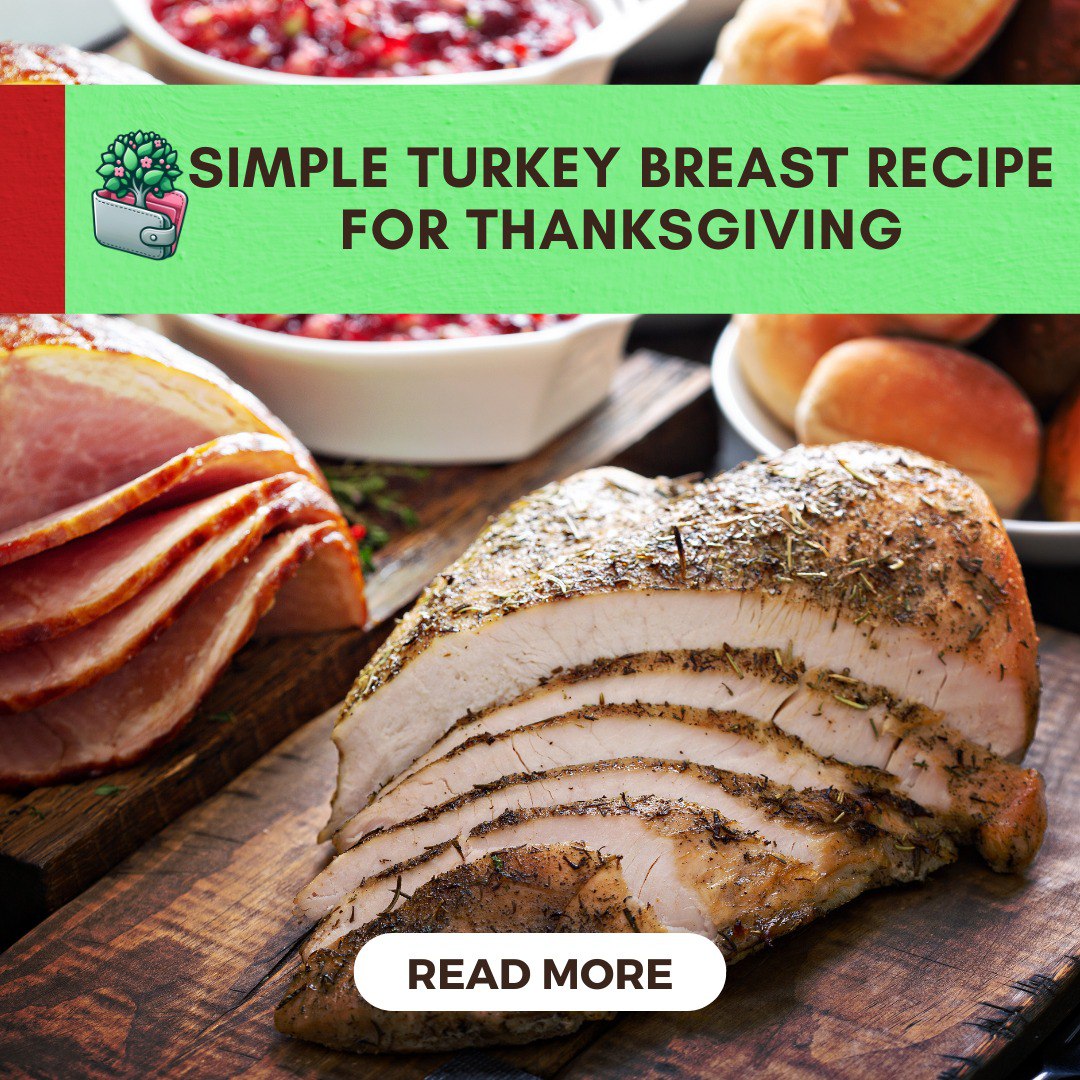Thanksgiving, a cherished holiday celebrated across the United States, is synonymous with a feast of delicious food, family, and gratitude. At the heart of this festive occasion lies the centerpiece of the dinner table: the turkey. While a whole turkey is a classic choice, a perfectly cooked turkey breast offers a more manageable and equally delicious option, especially for smaller gatherings or those who prefer a leaner cut of meat.
In this comprehensive guide, we will walk you through a simple yet foolproof turkey breast recipe for thanksgiving. From selecting the right turkey breast to mastering the art of roasting, we’ll cover every step to ensure your Thanksgiving dinner is a resounding success.
Whether you’re a seasoned cook or a novice in the kitchen, this recipe is designed to be accessible and easy to follow. With a few simple ingredients and a well-seasoned bird, you’ll be able to create a Thanksgiving feast that your family and friends will rave about for years to come.

Choosing the Right Turkey Breast
The first step to a delicious turkey breast is selecting the right one. Consider the following factors:
1. Size
Determine the number of guests you’re serving and choose a turkey breast accordingly. A general rule of thumb is to plan for about 1 pound of turkey per person. Depending on how many people there are, a half turkey breast can suffice.
2. Bone-in or Boneless
Bone-in turkey breasts are typically larger and more flavorful, as the bone helps to keep the meat moist during cooking. However, boneless breasts are easier to carve and may be more convenient for some.
3. Fresh or Frozen
Fresh turkey breasts offer superior flavor and texture, but they require careful handling and storage. Frozen turkey breasts are a convenient option, but they may need to be thawed in the refrigerator for several days before cooking.

Essential Ingredients and Equipment
To prepare a mouthwatering oven-roasted turkey breast, you’ll need the following ingredients and equipment:
1. Turkey Breast: Choose a high-quality turkey breast, either bone-in or boneless, based on your preference and the number of guests you’re serving.
According to Healthline, “The nutrients in turkey depend on the cut. For example, dark meat, which is found in active muscles such as the legs or thighs, tends to have more fat and calories than white meat — whereas white meat contains slightly more protein”
2. Herb Butter: Create a flavorful herb butter mixture by combining softened butter with fresh herbs like thyme, rosemary, and sage. You can also add minced garlic, lemon zest, or other aromatics for extra flavor.
3. Salt and Pepper: Season the turkey breast generously with salt and pepper to enhance its natural flavor.
4. Olive Oil: A high-quality olive oil will help to crisp the turkey skin and add a rich flavor.
5. Roasting Pan or Dutch Oven: A large roasting pan or Dutch oven is ideal for roasting the turkey breast.
6. Meat Thermometer: A reliable meat thermometer is essential for ensuring that the turkey breast is cooked to perfection.
Optional Ingredients
- Garlic: Minced garlic can be added to the herb butter or rubbed directly onto the turkey breast for extra flavor.
- Lemon: Lemon zest and juice can brighten the flavor of the turkey and add a citrusy note.
- Other Aromatics: Consider adding other aromatics to the roasting pan, such as onions, carrots, celery, or apple slices, to infuse the turkey with additional flavor.

Preparing the Turkey Breast
Here is how to prepare the turkey breast:
1. Thawing
If your turkey breast is frozen, thaw it in the refrigerator, allowing ample time for safe thawing. This typically takes about 24 hours for every 5 pounds of turkey. Avoid thawing at room temperature or in warm water, as this can lead to bacterial growth.
2. Pat Dry
Once thawed, pat the turkey breast dry with paper towels. Excess moisture can hinder browning and lead to a less crispy skin.
3. Seasoning
Generously season the turkey breast with salt and freshly ground black pepper. Don’t be afraid to season liberally, as some of the salt will be drawn out during cooking. For extra flavor, consider adding other seasonings like paprika, garlic powder, or onion powder.
4. Herb Butter Application
Create a flavorful herb butter by combining softened butter with fresh herbs like thyme, rosemary, and sage. You can also add minced garlic, lemon zest, or other aromatics. Rub the herb butter generously all over the turkey breast, including under the skin. This will infuse the meat with delicious flavors for the roast turkey breast recipe.
Roasting a Bone-In Turkey Breast
Now, let us talk about the roasting part in this roasted turkey breast recipe.
1. Preheat Oven: Preheat your oven to 350°F (177°C).
2. Place in Roasting Pan: Place the turkey breast, breast side up, in a roasting pan or Dutch oven. If desired, you can add vegetables like carrots, celery, and onions to the bottom of the pan for extra flavor.
3. Roast: Roast the turkey breast in the preheated oven for about 20 minutes per pound. For example, a 6-pound turkey breast would take approximately 120 minutes.
4. Basting: Every 30 minutes, baste the turkey breast with the pan juices. This helps to keep the meat moist and adds flavor.
5. Checking for Doneness: Use a meat thermometer to ensure the internal temperature reaches 165°F (74°C) in the thickest part of the breast. Avoid overcooking, as this can lead to dry meat.

According to Tastes Better from Scratch, “The real KEY to baking a perfect Thanksgiving Turkey is not to overcook it–that’s what dries out the meat, and you want to carve into a juicy, moist turkey on Thanksgiving! So, just plan ahead to get the timing right.”
Cooking Time and Temperature
- Cooking Time: The cooking time will vary depending on the size and type of turkey breast. A general rule of thumb is to allow 20 minutes per pound of turkey.
- Internal Temperature: The most reliable way to determine doneness is by using a meat thermometer. Insert the thermometer into the thickest part of the breast, avoiding the bone. The internal temperature should reach 165°F (74°C).
- Resting Time: Once the turkey breast has reached the desired temperature, remove it from the oven and let it rest for 10-15 minutes before carving. This allows the juices to redistribute, resulting in a more tender and flavorful bird.
Gravy and Pan Juices
The pan juices from roasting the turkey breast are a flavorful base for a delicious gravy. Here’s how to make it:
- Deglazing the Pan: While the turkey breast is resting, pour off any excess fat from the roasting pan. Place the pan over medium heat and deglaze it with a cup of broth or wine. Scrape the bottom of the pan to release any browned bits, which add depth of flavor to the gravy.
- Thicken the Gravy: To thicken the gravy, you can use a slurry of flour and water or cornstarch mixed with water. Gradually whisk the slurry into the pan juices, stirring constantly until the desired thickness is reached.
- Seasoning: Season the gravy with salt and pepper to taste. You can also add additional herbs and spices, such as thyme, rosemary, or sage, to enhance the flavor.
- Straining: Strain the gravy through a fine-mesh sieve to remove any lumps or particles. This will result in a smooth and silky gravy.

Serving and Pairing Suggestions
A perfectly roasted turkey breast is a versatile dish that can be paired with a variety of sides and flavors. Here are some serving and pairing suggestions:
Classic Pairings
- Mashed Potatoes: Creamy mashed potatoes are a timeless classic that complements the savory turkey breast.
- Cranberry Sauce: Tart cranberry sauce adds a bright and tangy flavor to the dish.
- Green Bean Casserole: A creamy and comforting side dish that pairs well with the turkey.
- Stuffing: A flavorful stuffing, whether it’s bread-based or cornbread-based, is a must-have for many Thanksgiving dinners.
Creative Pairings
- Roasted Root Vegetables: Roasted root vegetables like carrots, parsnips, and sweet potatoes add a touch of sweetness and earthiness to the meal.
- Brussels Sprouts with Bacon: Crispy Brussels sprouts with bacon are a popular and delicious side dish.
- Quinoa Pilaf: A healthy and flavorful grain-based side dish that can be customized with herbs, spices, and vegetables.
Beverage Pairings
- Wine: A crisp white wine, such as Chardonnay or Pinot Grigio, can complement the savory flavors of the turkey. For red wine lovers, a light-bodied Pinot Noir or Gamay can be a good choice.
- Beer: A light lager or pale ale can be a refreshing beverage to pair with the turkey.
By experimenting with different side dishes and beverages, you can create a unique and delicious Thanksgiving meal that will impress your guests.

Tips for a Perfect Boneless Turkey Breast
A boneless turkey breast is a great option for a smaller gathering or for those who prefer a leaner cut of meat. Here are some tips to ensure a perfect boneless turkey breast:
– Adjust Cooking Time and Temperature: Boneless turkey breasts cook faster than bone-in breasts. Adjust your cooking time and temperature accordingly. Typically, you’ll need to reduce the cooking time by about 25%.
– Avoid Overcooking: Overcooking is a common mistake that can lead to a dry and tough turkey breast. Use a meat thermometer to ensure that the internal temperature reaches 165°F (74°C).
– Basting: Basting the turkey breast with pan juices every 30 minutes helps to keep it moist and flavorful.
– Resting Time: Allow the turkey breast to rest for 10-15 minutes after cooking. This allows the juices to redistribute, resulting in a more tender and juicy bird.
Common Questions and Variations
Can I use a frozen turkey breast?
Yes, you can use a frozen turkey breast. Make sure to thaw it completely in the refrigerator before cooking. Adjust the cooking time accordingly, as frozen turkey breasts may take longer to cook.
How do I keep the turkey breast moist?
In addition to basting, you can also tent the turkey breast with foil during the last 30 minutes of cooking to prevent it from drying out.
Can I roast a turkey breast in a slow cooker?
Yes, you can roast a turkey breast in a slow cooker. However, it’s important to adjust the cooking time and temperature. Typically, a boneless turkey breast will take 6-8 hours on low or 3-4 hours on high.

Nutrition and Safety
– Food Safety: Always handle raw turkey with care. Wash your hands and surfaces thoroughly after handling raw turkey. Cook the turkey breast to a safe internal temperature of 165°F (74°C) to kill harmful bacteria.
According to FoodSafety.gov, “Leftovers should be stored within two hours of cooking. Divide leftovers into smaller portions and refrigerate or freeze them in covered shallow containers so they cool quickly.”
– Nutritional Value: Turkey breast is a lean protein source that is low in fat and calories. It’s also a good source of essential vitamins and minerals, such as niacin, selenium, and phosphorus.
– Healthy Alternatives: For a healthier option, consider using a natural or organic turkey breast, which may contain fewer additives and preservatives.
Oven-Roasted Turkey Recipe

Ingredients:
- 1 turkey breast (bone-in or boneless)
- 1/2 cup unsalted butter, softened
- 2 tablespoons fresh thyme, chopped
- 2 tablespoons fresh rosemary, chopped
- 2 tablespoons fresh sage, chopped
- 2 cloves garlic, minced
- 1 lemon, zested
- Salt and pepper to taste
- Olive oil
Instructions:
- Prepare the Turkey Breast:
- If frozen, thaw the turkey breast in the refrigerator.
- Pat the turkey breast dry with paper towels.
- Season the turkey breast generously with salt and pepper.
- Make the Herb Butter:
- In a small bowl, combine softened butter, thyme, rosemary, sage, garlic, and lemon zest. Mix well.
- Apply the Herb Butter:
- Gently loosen the skin of the turkey breast and spread the herb butter underneath.
- Rub the remaining herb butter over the top of the turkey breast.
- Roast the Turkey Breast:
- Preheat your oven to 350°F (177°C).
- Place the turkey breast in a roasting pan.
- Drizzle with olive oil.
- Roast for 20-25 minutes per pound, or until the internal temperature reaches 165°F (74°C).
- Baste the turkey every 30 minutes with the pan juices.
- Rest and Carve:
- Let the turkey breast rest for 15-20 minutes before carving.
- Carve and serve.
To Wrap Up on the Perfect Turkey Breast Recipe for Thanksgiving
By following this simple and delicious recipe, you can elevate your Thanksgiving dinner to new heights. A perfectly cooked turkey breast, golden brown and juicy, is the epitome of holiday comfort food. Remember, the key to success lies in preparation, patience, and a touch of love.
So, gather your ingredients, preheat your oven, and get ready to create a Thanksgiving masterpiece. With this guide, you’ll be well on your way to a memorable holiday celebration. Happy Thanksgiving!
Frequently Asked Questions
How do I keep my turkey breast from drying out?
To keep the turkey breast moist, baste it with pan juices every 30 minutes. You can also tent the turkey with foil during the last 30 minutes of cooking to prevent it from drying out.
How to prepare a fully cooked turkey breast for Thanksgiving?
To prepare a fully cooked turkey breast, simply reheat it in the oven at 325°F (163°C) until it reaches an internal temperature of 165°F (74°C). Cover it with foil to prevent it from drying out and baste occasionally with pan juices or broth for added moisture.
Is it okay to cook a turkey breast the day before Thanksgiving?
Yes, you can cook a turkey breast the day before. After cooking, let it cool, then refrigerate it. Reheat it on Thanksgiving Day by covering it with foil and warming it in the oven at 325°F (163°C) until it reaches 165°F (74°C). This saves time and reduces stress on the holiday.
Can I use a frozen turkey breast for this recipe, and how should I thaw it?
Yes, you can use a frozen turkey breast. It should be thawed in the refrigerator, allowing 24 hours for every 5 pounds of turkey to ensure safe and even thawing.
What are the key differences between bone-in and boneless turkey breasts, and which one should I choose?
Bone-in turkey breasts tend to be more flavorful and retain moisture better, but boneless turkey breasts are easier to carve and cook faster. The choice depends on your preference and the convenience you’re looking for.


